2018 Belt and Road Forum for Textile and Garment Industry Development enjoyed a great success in Urumqi
Sep 17, 2018 | by
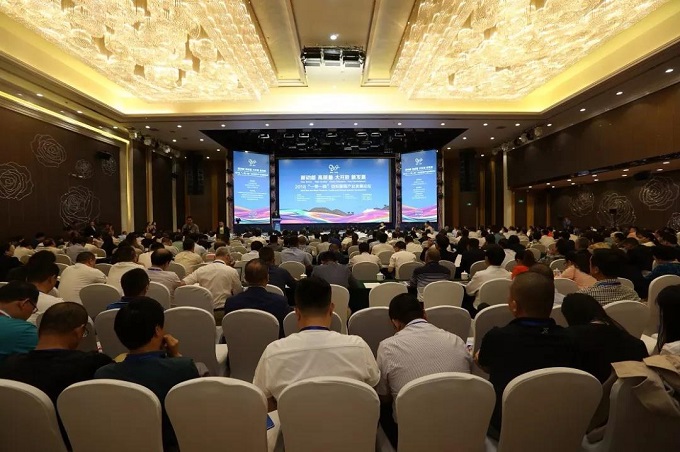
2018 Belt and Road Forum for Textile and Garment Industry Development, Sponsored by Ministry of Industry and Information Technology of the People’s Republic of China, People’s Government of Xinjiang Uygur Autonomous Region, and China National Textile and Apparel Council, and jointly organized by Leading Group Office for Development of Employment-Centered Textile and Apparel, Industry in Xinjiang Uygur Autonomous Region, The Economic and Information Commission of Xinjiang Uygur Autonomous Region, Department of Human Resources and Social Security of Xinjiang Uygur Autonomous Region, Xinjiang International Expo Administration, as well as China Textile Magazine and Jiangsu Jinsheng Industry Co., Ltd. Was successfully held in Urumqi, Xinjiang Uygur Autonomous Region on August 31st, 2018.
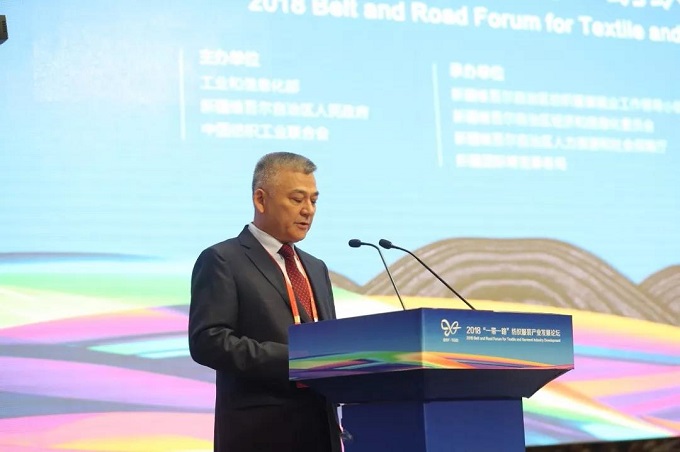
The forum was moderated by Weili · Balati, Director of The Economic and Information Commission of Xinjiang Uygur Autonomous Region.
As one of the important activities of the Asia-Europe Expo, this forum is based on the theme of “New Driver, High Quality, Great Openness, New Development”, comprehensively discussing the opportunities and challenges of Xinjiang’s textile and garment development in the new era, depending on the Belt and Road to help the development of Xinjiang textile and garment industry and jointly exploring the new growth driving force of the development of Xinjiang textile and garment industry.

Zhao Qing, Vice Chairman of the People’s Government of Xinjiang Uygur Autonomous Region, pointed out in his speech that over the past four years, the Xinjiang Uygur Autonomous Region Party Committee and the people’s government of the autonomous region have made full use of overlay advantages which include the implementation of the Belt and Road Initiative and the promotion of the “National Schema for Development of Employment-Centered Textile and Apparel Industry” put forward in 2014 which vows to provide one million jobs, vigorously promoting the development of Xinjiang textile and garment industry, and achieving remarkable results. Xinjiang cotton spinning industry scale and technical level ranks in the forefront of the country; apparel and home textile knitting industry has begun to take shape; the overall strength and development level of the industry has been improved; the scale of employment has significantly expanded. Basically, the country has established an important cotton textile industry base which is also a garment production base in the core area of the northwest region and the Silk Road Economic Zone.
The autonomous region has always adhered to the development concept and provided a strong policy guarantee for the healthy and sustainable development of the textile and garment industry. At the same time, we will continue to expand labor-intensive industries, help the policy of getting rid of poverty, and continue to expand the policy of supporting the textile and garment industry to promote employment. According to the Five-Year Program, by 2023, Xinjiang will have become the largest production base of high-quality cotton textile products in China, the largest textile export processing base in the western region and a distribution center exporting to the west.

Gao Yong, Party Secretary & Secretary-General of China National Textile and Apparel Council, said in his speech that the development of textile and garment industry in Xinjiang has been a hotspot and bright spot in the whole industry in recent years. The scale of the industry has grown steadily and the technical level has improved significantly. It has become an important processing and distribution base of cotton spinning, textile and garment in China. Textile and garment industry has become one of the main forces driving employment in Xinjiang. The future development space of Xinjiang is vast, and the layout and development of the textile and garment industry in Xinjiang will continue to deepen.
Gao Yong made several suggestions: First, we should accurately grasp the direction of industrial development and promote the high-quality development of Xinjiang textile and garment industry. With the five development concepts of “innovation, coordination, green, openness and sharing”, we will guide the overall development of the textile and garment industry, focus on improving the quality and efficiency of development, pay attention to the domestic and international market demand and the sustainable development of the industry, and rationally arrange and improve the textile and garment industry chain, which will first promote the formation of a characteristic industrial cluster with an efficient industrial chain. The second is to give full play to the geographical advantages of Xinjiang as the core area of the Silk Road Economic Belt and the Eurasian large-channel transportation hub, and to form a new advantage in the international development of the industry. The third is to make full use of Xinjiang’s resource advantages, accelerate the promotion of resource sharing, and create new advantages in the competitiveness of Xinjiang’s textile and garment industry. The fourth is to give full play to Xinjiang’s policy advantages and develop a textile and garment industry based on the national strategy of promoting social stability in Xinjiang and achieving targeted poverty alleviation.

Luo Wen, Deputy Director (minister level) of Ministry of Industry and Information Technology of the People’s Republic of China, said that since the Central Xinjiang Work Seminar clearly stated that the development of the textile and garment industry has driven the employment strategy, the Xinjiang textile and garment industry has developed rapidly. The cotton spinning and garment production capacity in Xinjiang has doubled, and the company’s efficiency has improved significantly.
Luo Wen put forward the following suggestions for the next step to accelerate the development of Xinjiang textile and garment industry: First, we should give full play to the advantages of cotton resources and raw materials are an important guarantee for important products. We should also further optimize cotton varieties in Xinjiang, improve the inherent quality of cotton, and accelerate the automation, digital and intelligent transformation of cotton spinning in Xinjiang. Second, we should increase the intensity of opening up and cooperation with the west. Third, we should pay attention to the green development of textile and apparel. President Xi Jinping pointed out that clean water and green mountain is the wealth. The development of the textile and garment industry should take into account the environmental carrying capacity, actively adopt advanced green manufacturing technologies, and give priority to the development of enterprises with large employment capacity and less environmental pollution. Fourth, we should create a better business policy environment. It is necessary to further strengthen the development strategy and planning research of Xinjiang textile and garment industry, optimize policy support and guidance, maintain basic policy stability and implementation, play a good role as an enterprise, enhance corporate development confidence, and create a fair and just business environment.

In the keynote speech, Li Gang, Associate Dean of Chinese Academy of International Trade and Economic Cooperation, analyzed the role of Xinjiang’s “core area” in promoting the high-quality development of the economy under the new situation. He said that the current impact of the Sino-U.S. trade uncertainty on the global economy still exists, which also puts new demands on us. To promote the high-quality development of the Belt and Road, the first is to work hard on project construction, establish a working mechanism, improve supporting support, and fully promote the project to make positive progress. Second, we must work hard to open up the market, build more trade promotion platforms, guide powerful enterprises to carry out investment cooperation with the countries along the line, develop new trades and new modes of cross-border e-commerce, and pay attention to trade balance. The third is to work hard on financial security, accelerate the formation of financial support to build a Belt and Road policy system, promote the internationalization of the renminbi in an orderly manner, guide social funds to be jointly invested in national infrastructure and resource development projects along the line, and provide enterprises going out with foreign exchange funding support.
Li Gang pointed out that it is necessary to give full play to the role of the core area of Xinjiang Silk Road Economic Belt. First, foreign trade and economic cooperation has been steadily advanced. Second, the level of infrastructure interconnection has been continuously improved. Third, the function of the carrier of the open and cooperation platform has been continuously improved. In the future, the textile and garment industry will have bright prospects in the Belt and Road.
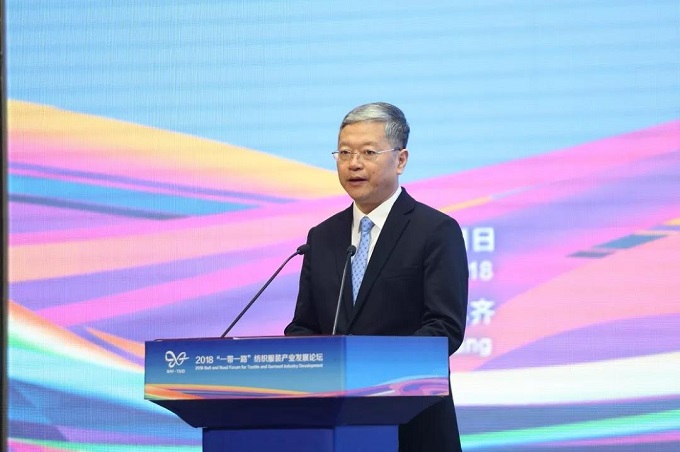
Xia Lingmin, Vice President of China National Textile and Apparel Council, pointed out in his speech that with the deepening of the construction of the Belt and Road, the advantages of Xinjiang textile are more prominent and the development potential is huge. In recent years, Xinjiang textile and garment industry has developed rapidly. The deepening of the Belt and Road construction will make the development advantages of the industry more obvious.
Xia Lingmin analyzed that from the perspective of the development of Xinjiang textile and garment industry, it still faces the problems and challenges in development that need to be overcome: the foundation of the development of terminal industry such as clothing and home textiles is still not reliable, and enterprises still have great difficulties in market development. There is still a big gap between the management level and mainland enterprises; local skilled industrial workers and management and technical backbone talents cannot keep up with the needs of industrial development. Trade circulation and professional markets are not strong enough for local textile and apparel manufacturing. The western market with the largest capacity has not yet been able to achieve a smooth connection. The system for the export of textiles and garments in the central and western Europe to the west has not yet been formed. These problems require to be solved by precise advice and continuous efforts.

Dr. Christian Schindler, Director General of International Textile Manufacturers Federation (ITMF), explained the characteristics of the development of global textile industry and the role played by China in the speech entitled “Global Textile Industry Development Pattern and Opportunities & Challenges for Xinjiang Textile and Garment Industry”.
According to Christian’s analysis, with the reduction of offline stores and the rapid expansion of e-commerce and mobile payments, China will become an important production and retail market in the world. At the same time, with the development of disruptive technology and changes in cost factors, the textile industry has always been eager to pursue higher production, and has been pursuing the reduction of energy consumption. The textile industry will continue to use new technologies to reduce energy consumption. In addition to daily energy consumption and cost reduction, as a textile company, we must pay close attention to the development trend of the industry: new technology can realize customized production in the future, and scale customization will make production closer to the requirements of consumers. The Internet of Things will bring us new opportunity and productivity.
Every year, ITMF conducts statistics on the shipment data of textile equipment. From these data, we can see where the future development trend of the textile industry is focused. In the past two years, China’s market share in the international textile industry has grown further than that in 2015. Although China’s energy costs and labor costs have increased, it is still an important target for world investment. Because many companies invest in the latest textile technology in China, they can maintain their competitiveness by investing in new technologies. At the same time, the global market generally holds positive judgment and confidence in the future development of China's textile and apparel.

Pan Xueping, Chairman & CEO of Jiangsu Jinsheng Holdings Co., Ltd. made a speech on the theme of “Using Xinjiang’s Superior Resources to Promote Rapid Development of the Enterprise”. Pan Xueping introduced that Jinsheng took advantage of the trend and took root in Xinjiang’s progress, and built “one center and five parks” in Xinjiang within about ten years. A smart machinery park is being built in the Economic Development Zone of Urumqi. The first is a textile factory; the second is an industrial park for green yarns in Kuitun; and the third is an industrial park for green yarns in Korla. In order to realize green technology and sustainable development in Xinjiang, Jinsheng proposed Internet plus green agriculture to create a new format of C2B model.
Pan Xueping said that Jinsheng should seize the historical opportunity of new kinetic energy, high quality, openness and new development, and promote the implementation of the Belt and Road project. As a high-end manufacturing company, Jinsheng will take advantage of the trend and strive to create a new business model, provide green and technological solutions, help the industry to transform and upgrade, and serve the Belt and Road.
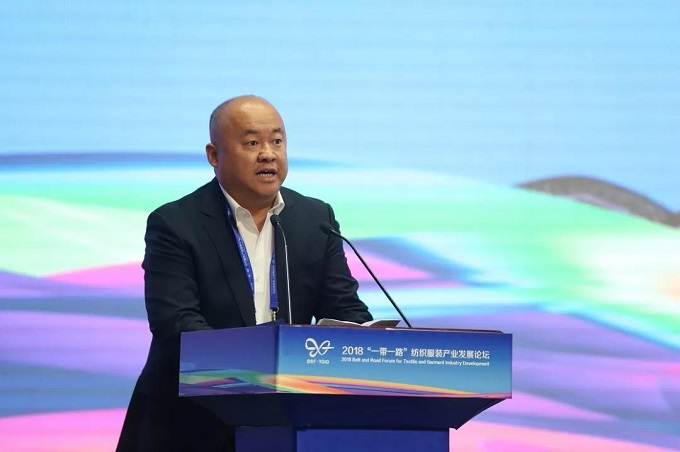
Ma Chunlei, Member of the Standing Committee of the Economic Development Zone District Committee and Deputy Director of Urumqi International Inland Port District Construction Committee said in the speech that Urumqi International Inland Port District has continuously enriched and improved trade channels and methods, serving the country to open to the outside world, smoothing both domestic and foreign markets, and building logistics organization platforms, international trade platforms and export-oriented industrial development platforms to promote trade prosperity and attract industries and global factor resources.
“The construction of Urumqi International Inland Port District has taken a solid first step. The next step will continue to focus on the development ideas of collecting goods, building gardens and gathering industries, and in 2018, we will improve the functional platform, strengthen investment attraction, and lay a solid foundation to achieve results. In 2019, we will promote the normality of the class, consolidate the infrastructure construction, agglomerate the industrial strengthening function, accelerate the industrial gathering in 2020, realize industrial landing, the overall pace of quality improvement and efficiency demonstration, and focus on improving the functional platform and the collection capacity. We will improve the core regional planning and promote resource integration as the support to achieve our ultimate goal that is attracting the industry to land, accelerate the construction of the international inland port area, and build a demonstration zone for export-oriented economic development.”

Zhang Xi’an, Vice President of China Chamber of Commerce for Import and Export of Textile and Apparel, summed up four major trends in the keynote speech from the trend of China’s textile and apparel export trade in recent years.
First, the continuous optimization of the trade structure has laid a solid foundation for the future high-growth and high-quality development. Second, the export is highly concentrated in the six coastal provinces and cities, and the central and western regions such as Xinjiang and Henan have achieved remarkable results in actively transferring to the east. Third, although China’s share of the international market has entered a downward channel, the rate of decline tends to slow down, and it is likely to remain basically stable in the medium and long term. Fourth, a number of leading enterprises, characteristic enterprises and foreign trade bases with international competitiveness have emerged in China, which effectively led the transformation and upgrading of textile and apparel foreign trade.
Zhang Xi’an made several suggestions on the development of the Belt and Road market in Xinjiang. “First of all, in the policy, we must give full play to the advantages of the cotton spinning industry and gradually improve the industrial chain. Second, we should give full play to the pivotal role of the Belt and Road, gradually enhance Xinjiang’s production capacity, strengthen logistics construction, reduce logistics costs, and make it a true transportation hub and trade logistics center. Third, we should actively attract enterprises to invest in Xinjiang. It is hoped that the government will give investment companies a more relaxed business environment and enhance their confidence in investment. Fourth, we should also actively explore new markets and diversify the risks of exports.”

An Wenjian, Deputy Chief of Headquarter for Aid to Xinjiang from Shandong Province, Deputy Commissioner of Kashgar Prefecture, gave a keynote speech on how to do a good job in assisting Xinjiang. An Wenjian said that the Shandong has supported the Kashgar region for 21 years and has achieved initial results in the development of the textile and garment industry in Kashgar.
In this regard, An Wenjian mainly introduced four aspects of practice. “First, we should adhere to the high-level promotion and strengthen planning and guidance. The overall positioning, industrial layout, and objectives of the textile and garment industry have been established, and professional support funds have been set up, which has enhanced the confidence of enterprises in supporting Kashgar. The second is to adhere to the support of the carrier and strengthen the construction of the park. The third is to persist in attracting investment and expand the scale of the industry. In the past five years, Shandong Aid Xinjiang Work Command has introduced 70 textile and garment enterprises with an investment of more than 5 billion yuan. The fourth is to persist in model innovation and help overcome poverty. Shandong’s new round of aid work for Xinjiang persists the basic model of innovation as an effective way to expand employment.”
An Wenjian said that the next step of Shandong’s industrial aid will fully rely on Kashgar’s location conditions and resource advantages to further accelerate the development of the textile and garment industry in Kashgar, and contribute to the efforts of local people to increase employment and improve living standards.

Leyla Pavlova, Co-founder of between2countries, gave a keynote on textile international trade and how to create a customer resource library. She introduced the status of Russian textile and apparel and related developments, and shared information on various important exhibitions. At the same time, she expressed her expectation for further strengthening the cooperation along the Belt and Road. She hoped more textile and garment enterprises will go out and promote the development of international trade.
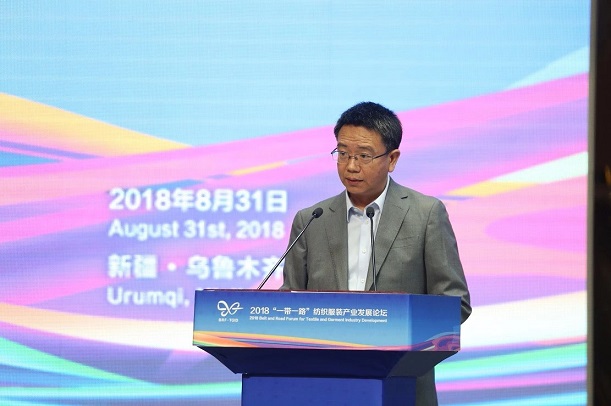
Liu Yong, Deputy Secretary & Director of Party Working Committee of Aksu Textile City (Development Zone), introduced in the keynote speech of “Stable Employment Experience of Textile and Garment Industry in Aksu Textile City”, that Aksu Textile City Development Zone is the national textile and garment industry demonstration district and the top ten industrial parks in China. Since the establishment of the development zone, especially after the second Xinjiang Work Forum in 2014, the Aksu region of the National Autonomous Region has successively issued a series of support policies for the development of the textile and garment industry. The foresighted entrepreneurs in the central and eastern regions are aiming at the geographical advantages, resource advantages, policy advantages and good business environment of the Belt and Road in Aksu, they have come in a continuous stream, and have invested in the Aksu Textile City. They have introduced well-known domestic textile and garment enterprises and promoted stable employment and industrial development as well as local employment, which achieved initial results.
ALL COMMENTS
All Comments
- by:VisitorMar 03, 2021
- Игровые автоматы и слоты в Украине имеют лицензию только в <a href=https://pin-up-casino999.ru/>Pin Up UA</a> Casino. Играя на деньги на официальном сайте казино вы поймете что аппараты обладают совершенно другой отдачей по сравнению со скриптами!
- by:VisitorOct 06, 2020
- <a href=ledtehnology.ru>светодиодный экран оптом</a> <br> <a href=ledtehnology.ru>светодиодный экран для магазина</a> <br> <a href=ledtehnology.ru>медиафасад стоимость</a> <br> <a href=ledtehnology.ru>купить медиафасад</a> <br> <a href=ledtehnology.ru>медиафасад купить</a> <br> <a href=ledtehnology.ru>светодиодный экран для помещений</a> <br> <a href=ledtehnology.ru>медиафасад цена</a> <br> <a href=ledtehnology.ru>светодиодные экраны</a> <br> <a href=ledtehnology.ru>медиафасад</a> <br> <a href=ledtehnology.ru>светодиодный экран купить</a> <br> <a href=ledtehnology.ru>светодиодный экран для улицы</a> <br> <a href=ledtehnology.ru>медиафасады</a> <br> <a href=ledtehnology.ru>светодиодный экран для сцены</a> <br> <a href=ledtehnology.ru>светодиодный экран цена</a> <br> <a href=ledtehnology.ru>уличный экран</a> <br> <a href=ledtehnology.ru>дорожные табло</a>
- by:VisitorJun 14, 2020
- нда-додумались и до такого...<br> <br> --- <br> я б поболел!!! скачать fifa, скачать фифа или <a href=http://15fifa.ru/skachat-fifa-15/28-fifa-15-ultimate-team-by-ea-sports-v107-sportivnyy-simulyator-ios-511-rus.html>fifa 15 ultimate team ios скачать</a> скачать fifa
|








